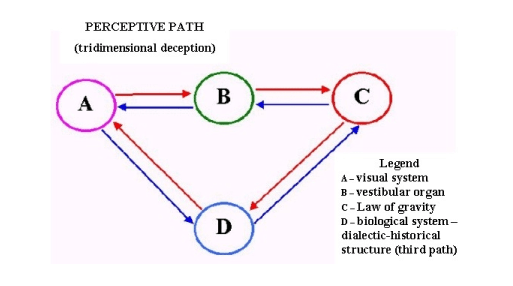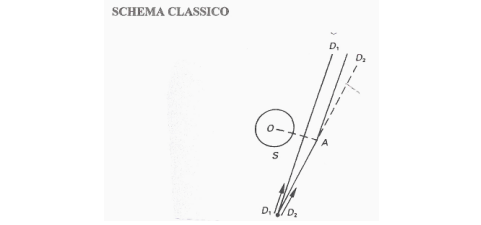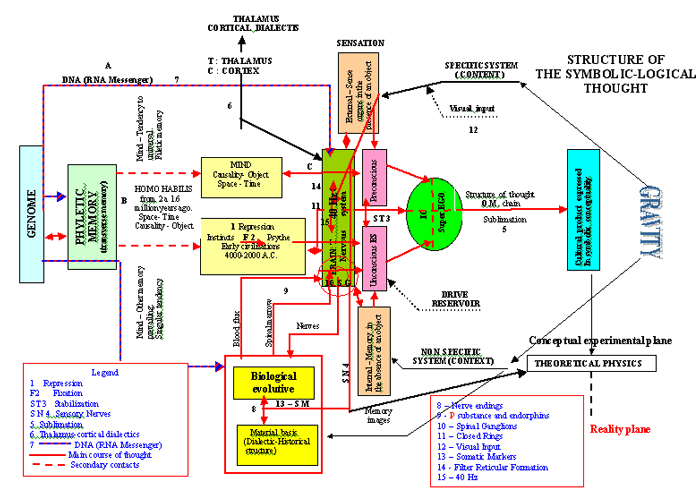PM
--> ENGLISH HOME PAGE
--> TOPICS AND AREAS
--> NEWS
--> PSYCHOBYOLOGY AND NEUROSCIENCE
|
PSYCHOMEDIA
|
SCIENCE AND THOUGHT
Psychobiology and Neuroscience
|
From the quantistic void to the geometric perception concerning the curvature of light and space
Prof. Roberto Ettore Bertagnolio
The set theory has a fundamental role in the formation of the mathematical language and corresponds to materialization of the neurological structure of the Mental Objects, following at the same time (as I have demonstrated) a rigid neuropsychoanalytic outline of mediation between unconsciousness and consciousness. The non-fortuitousness of the outline has also been proved for other purposes in the neuroscientific field in the latest cognitive research led at California Institute of Technology by Christof Koch and Susan Greenfield(1), in which they focus the non-fortuitousness of the net of neurons for a specific perceptibility. The alignment of neuron graphs that is next realized in the set theory through complex phases, would not be possible if at the basis there were not the framework of Consciousness, with its two key systems: specific (content) and non- specific (context). Naturally, this involves deep anomalies for the mathematical structure hence deriving, caused by the "disparity" between the two systems. Such anomalies are not solvable on the plan of the formal language, which is not a simple EXPEDIENT, (P. Maddy)(2). Instead, it has a deep-rooted origin in a neurological dimension that interlaces with the perceptive laws. The set theory structure, as an "objectified" language, is "apparently" also formed of "Impure" sets, namely sets determined by physical objects and possessing a space-time positioning; they are subject to the cognitive limits that such condition involves. The final materialization of these neuroperceptive foundations in the mathematical structure, also including the unknown quantity X, (corresponding to Kant's X) turns out to be:
1) M. O. = set Ø
2) 2) V. (void) = Ø is not Ø
3) INTERSECTION UNKNOWN QUANTITY, the void presupposes a very complex psychical content, already brilliantly intuited by Kant. (Richard Trudeau, p. 130 ref. "critics of pure reason"; also see my study on the intersection unknown quantity - Sciences web news).
ACCEPTING THAT VOID IS NOT SUCH
This means that apparently the mathematical logic founded on the non-void coincides with the QUANTISTIC VOID, but that is not true: the quantistic void is populated by pairs of virtual particles and antiparticles that appear and are cancelled. The void inborn in the logical-mathematical neurostructure is not identified in this, because the specific neurological material prevents neurostructure from joining such logic. That material represents and independent logical bond, not from Physics but from reality of things (intelligence of nature or evolutionistic logic). In this way, the mathematical structure is an ALIENATION from Reality, the maximum product of such alienation is the ABSOLUTE OBJECTIVITY DOGMA. All the astrophysical phenomena of the last 50 years, till the theory of the strings, are interpretations distorted by a symbolic logical structure interlaced to the anomalous relationship in the western thought between Subject and Object, an anomaly of neuroperceptive kind that refers to the cortical thalamus dialectic.
THE ENUNCIATION: VOID IS NOT EMPTY. At first sight, it corresponds to the same basic axiom for the number structure (3). In other words, the foundations of Mathematics start from this cognitive ambiguity, that is from the fact that a non empty space is believed to be, only apparently coincident with a fluctuation of quantistic void, when a pair formed of a particle and its antiparticle can appear from nothing and soon disappear. The neurological contribution forbids the mathematical language to comply with such reality.
SETS, PERCEPTION AND GEOMETRY
According to Platonism, all the sets are objects separated from the temporal-space dimension, that is immaterial objects, even if their elements are natural objects. But sets are also formed of "physical objects", therefore in this case we must consider the "temporal-space" dimension and its debatable "perceptive" logic. At this point, the question is: do impure sets really exist and the entire Euclidean geometry with them, or are they a perceptive error? On this plan, no solid reason justifies them, except the fact that the so-called impure sets derive from a movement of the closely neurostructural axis. Such operation becomes a tridimensional anomaly formed of synchronized elements(4) and of the binocular vision: they contribute to the depth of vision along with more factors like the "gravitational transversality" in LIGHT. The axis is surely moved from the SPECIFIC SYSTEM (CONTENT) to the NON SPECIFIC SYSTEM (CONTEXT). The light and the gravitational tension recognized by Einstein create, beside the non specific system, the illusion even of the space.
The structural gap between outside and inside is interiorized in the Cortical-Thalamus macro dialectic. The differences inside this dialectic appear in macro in the contradictions between Context and Content and distort the Object-Subject relationship. This caused the hardening of concept and prevented the XX century Physics from finding a solution to its epistemologic contradictions.
Imanuel Kant's intuition was a Copernican revolution: it dismantled the Euclidean geometry from the external matter (object) but unfortunately reinserted it through the transcendental categories, with the same absolute priority in mind. Yet, the German philosopher could not do more, the cognitive neuropsychology and other similar sciences were still to come and the dialectic perceptive mechanisms were still TABOOS. Now we know the neurological mechanisms lying at the basis of such dialectic, and we also know all the components that produce the perceptive anomalies, starting from the original gap between unconsciousness and cosciousness, between context and content, between specific and non specific, between presumed Euclidean outside and non Euclidean inside.
In the nineteenth-century thought, the prototypes of this dialectic were exactly Kant on the one side, and Lobacevskij on the other. It apparently seems a classic contrast between two dialectic poles, subjective and objective, the former of the geometrical categories submerged in the transcendental space and independent from any empiricist origin (Kant), and the latter as the immanent thought with the categories submerged in the physical space (three-dimensional). But in the most meaningful steps of Lobacevskij, highlighted by Lombardo Radice(5), the sense changes completely: "The contact constructs the characteristic attribute of bodies; they derive the name of geometric bodies out of it as soon as we concentrate on this property, and we do not consider all other properties either essential or accidental. Or "....in nature there are neither straight lines, nor curves, nor plans, nor superficial curves: only bodies are found in it so that al the rest, created by our imagination, only exists in theory. With the concept of CONTACT he anticipated what in the future would be revealed by neuroscience, cognitive psychology and modern pedagogy, which always asserts the importance of physical contact at the basis of learning and formation of the structure of thought by means of Mental Objects. The empiricist contact with matter is found in the cognitive experience of reality by blind people, and in the experience founded on the Montessori method, which insists on the manipulation of matter by children as something essential for the formation of the structure of thought.
The missing solution of the dialectic OBJECT-SUBJECT, a problem that goes through the history of the western thought, is in my opinion to be brought back to the perceptive problem, an issue still open, tied indirectly to the three-dimensional illusion, which I think partially explains the strategies at the basis of both elliptic and hyperbolic geometry. The resolution involves on the geometric plan a structure that exceeds the EUCLIDEAN - NON EUCLIDEAN dualism, in order to obtain a PLANE MONODIMENSIONAL geometric vision.
THE MISSING DIALECTIC RESOLUTION ON THE ISSUE SUBJECT-OBJECT, IN PHYSICS, HAS LED TO INCORRECT CONSIDERATIONS, PARTICULARLY IN THE CONCEPTION OF THE GRAVITY -PERCEPTION RELATIONSHIP. THE ERROR IS IGNORING COMPLETELY THE UNICUM OF THE CONCEPT OF LIGHT AND ITS GRAVITATIONAL TRANSVERSALITY ALSO IN THE PERCEPTION OF SPACE.
IT IS NECESSARY TO SET THE POINT.
ENUNCIATIONS:
1) The Universe is infinite and is composed of numberless big bangs and big crunches, *final collapse of the universe.
2) Tridimensionality is a perceptive anomaly and the curved space is the cognitive result of the anomaly.
3) Mathematics cannot verify the concept of infinite, therefore it cannot give any opinion on the fifth Euclidean postulate.
4) The path of logical intuition of the concept of infinite only occursat a neuropsychological level.
5) The only possible geometry is: monodimensionale plane geometry.
6) The Universe has to be intended with infinite big bangs and big crunches, not as a "multiverse" but as an only universe that respects the laws of thermodynamics, the infinite universes that make up a "unicum". These universes are born and die like stars(6). When he modifies the Newtonian law on gravity, as a result of the intrinsic limitations to the speed of light and for the impossibility to send signals at a greater speed, Einstein introduces into the modified theory the concept that every object is equipped of both mass and energy; therefore the light itself feels the gravitational attraction, from that moment the rectilinear trajectory of light is perceived as curvilinear. All that does not demonstrate the curvature of light, but simply "the unicum" of gravity transversality about the variation of perception. The variation happens when when the reflected light of an object hits the retina in electrochemical impulses. (S.M. Cosslyn, Researches on mental images). This is not enough to give a mental image the three-dimensional illusion. The retina is part of the specific system (content), but to create inside the mental image the perception of tridimensionality, it needs stimulationg inside the THALAMUS-CORTICAL dialectic (T-C), as well as the structural system related to memory images, that is the NON SPECIFIC SYSTEM (CONTEXT). Exactly the structural gap between the two systems (ORIGINAL ANOMALY) starts the obviously tridimensional space curvature. This anomaly is also accentuated by the BINOCULAR vision, contributing towards the perception of depth. (Kosslyn, "The images of the mind", Ed. Giunti, p. 102). Every eye frames the world from a slightly different angle, because of the five centimetre distance between the pupils, and the two shots combine in one tridimensional vision.
For more elements, see my scheme concerning synchronization.

ENUNCIATION:
NEITHER THE CURVATURE OF LIGHT OR OF SPACE IS DEMONSTRATED. EXACTLY THE TRANSVERSAL UNICUM OF GRAVITY BELONGING TO THE LIGHT INSIDE VISION LEADS TO THE PERCEPTIVE ERROR. IT IS IMPORTANT TO DIFFERENTIATE "SPACE - MATTER - MASS AND LIGHT". NOT IDENTIFYING THE UNICUM MADE EINSTEIN INVERT THE REAL AND APPARENT POSITION ORDERS OF STAR X.
SCHEME OF THE CLASSIC DEMONSTRATION OF GENERAL RELATIVITY
(verified by the English physicist Arthur Eddington off the Spanish Guinea coast).
(picture 5)

If there were not the Sun (S), a star at an infinite distance should be seen in direction D1 if watched from the Earth. Though, as a consequence of the deflection of the light coming from the star caused by the Sun, the star will be seen in direction D2, that is at a distance from the centre of the Sun a little higher than its real position. (La Scienza, UTET).
Historiography of the experiment considered the classic demonstration of validity of general relativity.
During the eclipse of May 29, 1919, the English physicist Sir Arthur Eddington organized two scientific expeditions, one off the Spanish Guinea and the other in Soblarl in Brazil. The results of those observations, given the curvature of light, demonstrated the validity of general Relativity. In reality it was the demonstration of the new gravitational theory that gives energy and mass to light (which Newton had not found), but not of the curvature of light and of space in general. Einstein has no ideas about the new perceptive mechanisms, they are still distant, and above all he does not know the unicum of light. He himself gave it energy and mass, but in that way he (obviously) could not notice the influence of gravity on the perception of tridimensionality, as the experiments to zero gravity demonstrated. (experiments to zero gravity - E.S.A. ITALIA organizations).
SCHEME MODIFIED ACCORDING TO THE NEW GRAVITATIONAL LAW WITH THE TRANSVERSAL EFFECTS FORMING THE UNICUM OF LIGHT, INFLUENCING THE OPTICAL-PERCEPTIVE SYSTEM THROUGH THE CORTICAL-THALAMUS DIALECTIC AND RECOGNIZING THE SPACE AAND MATTER AS INFINITE.

Not recognizing the unicum of light and the concept of infinite space, makes invert the position of stars, finding as a remedy the solution of space incurvation.
GENERAL SCHEME OF THE SYMBOLIC-LOGICAL THOUGHT, INCLUDING THE ORIGINAL ANOMALY AS THE BASIS OF TRIDIMENSIONAL PERCEPTION. (The cultural result expressed in mathematical terms is equivalent also at the level of theoretical Physics, both levels do not correspond to the real level).

Notes:
1 Sciences, January 2008, n. 473, Christof Koch and Susan Greenfield- As the conscience is born, from p. 92 to p.99.
2 Penelope Maddy, Realism in Mathematics, Clarendon Press, Oxford 1990 p. 157.
3 Mario Piazza, Intorno ai numeri, Ed. Bruno Mondadori, MI, 2000, in particular outline p. 75.
4 Roberto Ettore Bertagnolio, Outline on synchronization, Sciences web news.
5 Introductory essay by Lombardo Radice to N.I. Lobacevskij (1963), p. 68-73.
6 1) Energy is neither created nor is destroyed, but it is transformed. 2) Heat moves spontaneously only from a warmer body to a colder one. Only a part can be transformed into work. It is impossible to make a machine able to transform all the heat into work. See also studies in "Cosmology", ed. Cuen (quaderni divulgazione), Naples 1997 - pages 65-84, and Silvio Bercia, "La seconda legge della termodinamica e l'espansione dell'universo".
PM
--> ENGLISH HOME PAGE
--> TOPICS AND AREAS
--> NEWS
--> PSYCHOBYOLOGY AND NEUROSCIENCE
|



